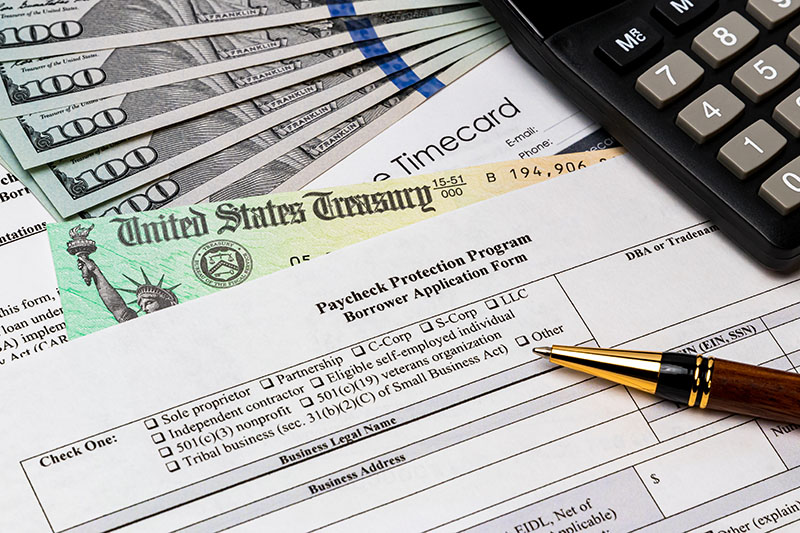January 6th, 2021
Tax Provisions of the Emergency Coronavirus Relief Legislation
Posted in: Featured Tax Law Tagged: Coronavirus, David S. De Jong
Author: David S. De Jong

As part of the Consolidated Appropriations Act 2021, the lengthiest legislation in U.S. history at more than 5500 pages, Congress enacted further tax relief to those adversely affected by the coronavirus but including additional provisions. Here are the most significant tax provisions:
Individuals
- Extends through 2025 the exclusion on employer payment of student loans up to $5,250 per year as part of an educational benefit plan
- Makes financial aid grants under the CARES Act excludable from the income of university students and provides that receipt does not affect eligibility for either the American Opportunity or Lifetime Learning tax credit
- Extends through 2025 the exclusion from gross income on discharge of acquisition indebtedness on a principal residence irrespective of insolvency but reduces the maximum exclusion effective 2021 from $2 million to $750,000
- Repeals the above the line deduction for qualified education expenses and replaces it after 2020 with higher phaseout limits on the lifetime learning credit of $58,000-$80,000 (double for joint filers)
- Makes personal protective equipment and other supplies for the prevention of COVID after March 11, 2020 eligible for the above the line deduction for educator expenses
- Makes permanent the exclusions of up to $50 per month for reimbursement payments to volunteer first responders and for any state or local tax benefit
- Makes permanent a restoration of the 7½ percent floor on medical expenses as an itemized deduction
- Allows plans to permit flexible spending arrangements to carryover unused 2020 and 2021 amounts to the succeeding year, allows raising the maximum age for eligible dependents from 12 to 13 for 2020 and allows midyear prospective changes in elections during 2021
- Extends through 2021 the treatment of mortgage insurance premiums (PMI) as home mortgage interest phasing out for those with adjusted gross income greater than $100,000
- Extends the 100 percent of adjusted gross income limitation on charitable contributions by itemizers through 2021 and doubles the $300 limit for married itemizers for 2021 and restructures that deduction so as not to reduce AGI
- Creates a new $600 per person refundable tax credit per family member phased out at $5 per additional $100 of income over a $75,000 modified adjusted gross income level for singles, $112,500 for heads of household and $150,000 on joint returns with advance payments generally based on 2019 MAGI; nonfilers with social security or disability income will also receive advance payments
- Extends through 2021 the lifetime credit of $500 for the purchase of nonbusiness qualified energy improvements to a principal residence.
Retirement Planning
- Clarifies that the penalty-free withdrawals through 2020 from certain retirement plans with recontribution possible through 2022 applies to money purchase pension plans as well as profit sharing plans
- Precludes deemed plan terminations if the number of active participants on March 31, 2021 is at least 80 percent of the number as of March 13, 2020.
Business
- Clarifies that expenses paid with forgiven PPP loans and EIDL loans are deductible and that tax basis in the assets of a business is unaffected by forgiveness
- Restores the 100 percent deduction for business meals “provided by a restaurant” and paid or incurred in 2021 and 2022
- Allows C corporations to deduct charitable contributions up to 25 percent of tentative taxable income for 2021 as in 2020
- Allows farmers to elect a two-year net operating loss carryback instead of the five-year carryback of the CARES Act and, accordingly, allows revocation of an election to waive the carryback
- Creates a floating interest rate for determining whether a life insurance policy qualifies as a “life insurance contract” effective for contracts lifted entered into after 2020
- Extends the empowerment zone tax incentives through 2025 but eliminates increased expensing and capital gains tax deferrals after 2020
- Extends the employee retention tax credit through June 30, 2021, increasing the credit rate from 50 to 70 percent, allowing advance payments, reducing the required gross receipts decline from 50 to 20 percent, increasing creditable wages from $10,000 per year to $10,000 per quarter and changing from 100 to 500 the maximum number of employees a business can have and still claim the credit for workers still on the job
- Clarifies retroactively that employers who receive PPP loans remain eligible for the employee retention tax credit as to wages not paid for with forgiven PPP money and that group health benefits are considered wages even when no other compensation is paid to an employee
- Extends the refundable payroll tax credit for paid sick and family leave, originally in the Families First Coronavirus Response Act, for an additional calendar quarter through March 2021
- Extends the 12½ to 25 percent credit for paid family and medical leave through 2025
- Extends the Work Opportunity Credit through 2025
- Spreads out the repayment period on deferred employee portions of social security through December 31, 2021 with penalties and interest accruing thereafter.
Read New COVID-19 Relief Legislation Contains Paycheck Protection Program Modifications for more on changes to PPP.
You can find more on issues affecting businesses and individuals in our COVID-19 Resource Center.






